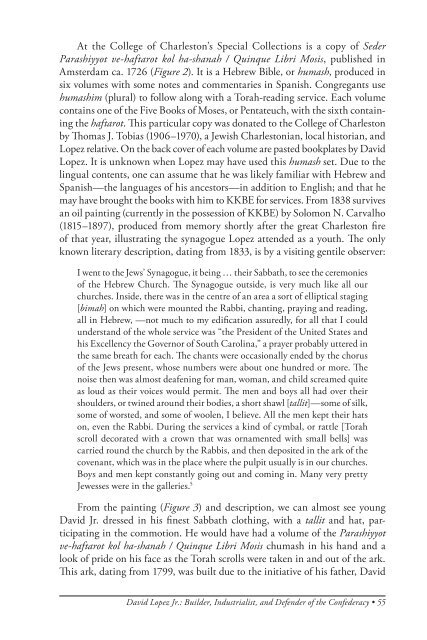American Jewish Archives Journal, Volume 64, Numbers 1 & 2
American Jewish Archives Journal, Volume 64, Numbers 1 & 2
American Jewish Archives Journal, Volume 64, Numbers 1 & 2
You also want an ePaper? Increase the reach of your titles
YUMPU automatically turns print PDFs into web optimized ePapers that Google loves.
At the College of Charleston’s Special Collections is a copy of Seder<br />
Parashiyyot ve-haftarot kol ha-shanah / Quinque Libri Mosis, published in<br />
Amsterdam ca. 1726 (Figure 2). It is a Hebrew Bible, or humash, produced in<br />
six volumes with some notes and commentaries in Spanish. Congregants use<br />
humashim (plural) to follow along with a Torah-reading service. Each volume<br />
contains one of the Five Books of Moses, or Pentateuch, with the sixth containing<br />
the haftarot. This particular copy was donated to the College of Charleston<br />
by Thomas J. Tobias (1906–1970), a <strong>Jewish</strong> Charlestonian, local historian, and<br />
Lopez relative. On the back cover of each volume are pasted bookplates by David<br />
Lopez. It is unknown when Lopez may have used this humash set. Due to the<br />
lingual contents, one can assume that he was likely familiar with Hebrew and<br />
Spanish—the languages of his ancestors—in addition to English; and that he<br />
may have brought the books with him to KKBE for services. From 1838 survives<br />
an oil painting (currently in the possession of KKBE) by Solomon N. Carvalho<br />
(1815–1897), produced from memory shortly after the great Charleston fire<br />
of that year, illustrating the synagogue Lopez attended as a youth. The only<br />
known literary description, dating from 1833, is by a visiting gentile observer:<br />
I went to the Jews’ Synagogue, it being … their Sabbath, to see the ceremonies<br />
of the Hebrew Church. The Synagogue outside, is very much like all our<br />
churches. Inside, there was in the centre of an area a sort of elliptical staging<br />
[bimah] on which were mounted the Rabbi, chanting, praying and reading,<br />
all in Hebrew, —not much to my edification assuredly, for all that I could<br />
understand of the whole service was “the President of the United States and<br />
his Excellency the Governor of South Carolina,” a prayer probably uttered in<br />
the same breath for each. The chants were occasionally ended by the chorus<br />
of the Jews present, whose numbers were about one hundred or more. The<br />
noise then was almost deafening for man, woman, and child screamed quite<br />
as loud as their voices would permit. The men and boys all had over their<br />
shoulders, or twined around their bodies, a short shawl [tallit]—some of silk,<br />
some of worsted, and some of woolen, I believe. All the men kept their hats<br />
on, even the Rabbi. During the services a kind of cymbal, or rattle [Torah<br />
scroll decorated with a crown that was ornamented with small bells] was<br />
carried round the church by the Rabbis, and then deposited in the ark of the<br />
covenant, which was in the place where the pulpit usually is in our churches.<br />
Boys and men kept constantly going out and coming in. Many very pretty<br />
Jewesses were in the galleries. 5<br />
From the painting (Figure 3) and description, we can almost see young<br />
David Jr. dressed in his finest Sabbath clothing, with a tallit and hat, participating<br />
in the commotion. He would have had a volume of the Parashiyyot<br />
ve-haftarot kol ha-shanah / Quinque Libri Mosis chumash in his hand and a<br />
look of pride on his face as the Torah scrolls were taken in and out of the ark.<br />
This ark, dating from 1799, was built due to the initiative of his father, David<br />
David Lopez Jr.: Builder, Industrialist, and Defender of the Confederacy • 55
















